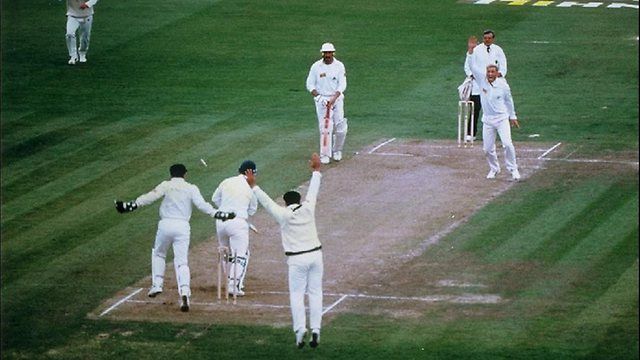
The Ashes Legends – Shane Warne: The Ball of the Century

The Ball of the Century: Shane Warne’s first delivery in Ashes to Mike Gatting
“Gatting has absolutely no idea what has happened to him.. Still doesn’t know.”
Richie Benaud said this on 4th June 1993, after Shane Warne clean bowled Mike Gatting with the most celebrated cricket delivery of all time, and chances are high that Gatting is still clueless and searching for the answers to the delivery.
It was the moment when Shane Keith Warne, the superstar, had truly arrived. The 23 year old relatively unknown cricketer was suddenly catapulted into stardom with his first delivery in test cricket on English soil and was the beginning of a period of his dominance over the English batsmen, which lasted for more than a decade. It was also the moment, which brought about the revival of the art of leg spin bowling.
It was the first test of the year’s Ashes, being played at Old Trafford. Shane Warne, despite showing early promise, had a quiet start to his career, having taken 31 wickets in 11 tests at a very modest average of 30.80, coming into the series. In the warm-up games leading to the Ashes, Warne was told by skipper Allan Border to not give the English players a glimpse of his trickery and prevent them from getting familiar with his bowling.
The Old Trafford pitch suited spin and the English team played two spinners in Phil Tufnell and Peter Such. But the Aussies went into the match with three pacers and the inexperienced Warne as the lone spinner. English captain Graham Gooch won the toss and invited the Aussies to bat first. Despite Mark Taylor’s century, the visitors could manage only a moderate total of 289 in their first innings.
In reply, the English team was at the score of 80 for 1, losing Mike Atherton to Merv Hughes, with Gooch and Gatting at the crease. It was then that Border tossed the ball to his spinner Warne with Gatting, an excellent player of spin and batting at 4*, to face his bowling, and the story of “the ball” began.
Taking a slow and short run up of a few paces, Warne rolled his right arm over and bowled a leg break to Gatting. The rapidly spinning ball bounced several inches outside the right handed Gatting’s leg stump. It seemed as if the ball would end up being a casual first ball to loosen up, and drift down the leg side. The batsman’s response was to thrust his left leg forward towards the pitch of the ball, and pushed his bat next to the pad. It was a commonly used tactic by batsmen, as they couldn’t be given out LBW to a ball landing outside the leg stump, and in case the ball hit the bat, it would quickly and safely bounce to the ground.
However, the ball ended up spinning far more than expected, and went past the outside edge of Gatting’s bat, going on to hit the top of the off stump and dislodging the bails. The look on Gatting’s face as he saw his stumps disturbed was priceless, and Gooch, who was watching from the other end of the pitch, later remarked, “He looked as though someone had just nicked his lunch!”
Dickie Bird, umpiring from the bowler’s end, rates the delivery as one of the best he ever umpired in a 23 year career. After the delivery, he told Warne “Shane, you’ll put your name in the record books”. And Warne surely didn’t disappoint.
Warne went on to take four wickets each in both innings of the English team in the match to help Australia win by 179 runs. But it was his very first delivery of the game, which totally bamboozled Gatting that has become the stuff of cricketing legends. It is still remembered fondly today by cricket fans worldwide. More importantly, as pointed out by Mark Taylor, the real legacy of the ball was the revival of the art of leg spin bowling, which was beginning to go stale. The delivery made people get up and notice that a leg spinner could be as effective in troubling the batsmen as a super fast pacer could.
Warne recently modestly called the delivery “a fluke… I was lucky for it to happen… It was meant to be”. But indeed, it was meant to be a special ball… “The Ball of the Century”.